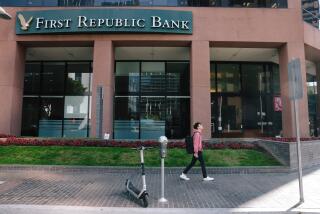Reserves Cited in Wells Fargo, Other Banks’ 2nd-Quarter Losses
SAN FRANCISCO — Wells Fargo & Co., joining its peers in acknowledging the need to increase reserves to cover anticipated loan losses abroad, Tuesday made a special $550-million addition to its allowance for loan losses, a move that resulted in a second-quarter net loss of $293.7 million.
Separately, four New York banks--Citicorp, which kicked off the industry trend in May by announcing a special $3-billion addition to its reserves; Manufacturers Hanover; Bankers Trust, and Irving Bank Corp.--as well as First Interstate Bancorp of Los Angeles all reported big losses.
Wells Fargo, despite its second-quarter loss, said it expects to post a modest profit for all of 1987. Without the special provision, Wells Fargo said it would have posted a 26% gain in net income for the second period, to $83.6 million.
Wells Fargo, now the nation’s 10th-largest banking company, has been aided by tight expense controls and the rapid positive contribution of last year’s purchase of Crocker National and has been a standout performer.
“Because of the strength of our basic businesses, we expect to resume our positive earnings trend following this special addition (to loan-loss reserves) and will continue the common stock dividend at the current rate,” Carl E. Reichardt, chairman and chief executive, said.
Analysts said Wells Fargo was unusually aggressive in reserving for loans in developing nations. As a result of the special charge, at least 40% of its loans to those countries are covered by the reserve.
For the first six months of 1987, Wells Fargo had a net loss of $215.4 million, versus net income of $117.7 million in the first half of last year.
First Interstate’s second-quarter net loss totaled $469.8 million for the second quarter and $386.3 million for the year to date.
The results reflected the company’s earlier decision to add $750 million to its reserve--$500 million to cover loans to developing nations and an additional $250 million to cover expected losses from an accelerated program to sell off non-performing domestic loans and foreclosed property. Its reserve now covers 25% of its loan exposure in developing nations.
“Increasing the loan-loss provision at this time enhances the potential for earnings growth in 1988 and the years beyond,” Chief Executive Joseph J. Pinola said. “We do not anticipate any interruption in the payment of dividends. . . . “ First Interstate is the ninth-largest U.S. bank firm.
Citicorp, as expected, posted the biggest quarterly loss ever for a banking company. The nation’s largest banking concern had a net loss of $2.59 billion in the second quarter and $2.32 billion in the first half.
Without the $3-billion special charge, Citicorp would have earned $288 million and $552 million in the quarter and half, respectively, up from $235 million and $505 million a year earlier.
Manufacturers Hanover, the fifth-largest American banking company, also broke the billion-dollar barrier for losses, posting a second-quarter deficit of $1.37 billion and a first-half loss of $1.29 billion.
Manufacturers had earlier announced a $1.7-billion special addition to loan-loss reserves without which its second-quarter net income would have fallen modestly to $88.4 billion from $93.9 million a year ago.
Bankers Trust, the eighth-largest bank company, said it lost $554 million because of its previously announced decision to add $700 million to its loan-loss reserve.
Bankers Trust raised its loan-loss provision to $1.3 billion and, but for that decision, its second-quarter income would have been 11% higher than last year’s figure, the bank said.
New York-based Irving Bank Corp., the nation’s 20th-largest banking firm and parent of Irving Trust, posted a $142-million second-quarter loss after adding $241 million to its loan-loss reserves.
More to Read
Inside the business of entertainment
The Wide Shot brings you news, analysis and insights on everything from streaming wars to production — and what it all means for the future.
You may occasionally receive promotional content from the Los Angeles Times.










